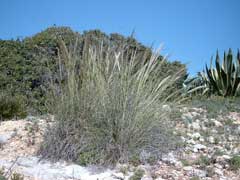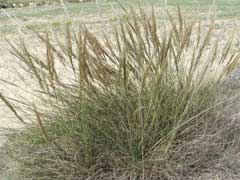 |
|
http://commons.wikimedia.org/wiki/User:Lumbar |
 |
| http://commons.wikimedia.org/wiki/User:Xemenendura |
Translate this page:
Summary
Physical Characteristics

 Macrochloa tenacissima is a PERENNIAL growing to 1 m (3ft 3in).
Macrochloa tenacissima is a PERENNIAL growing to 1 m (3ft 3in).
See above for USDA hardiness. It is hardy to UK zone 8 and is not frost tender. The species is hermaphrodite (has both male and female organs) and is pollinated by Wind.
Suitable for: light (sandy), medium (loamy) and heavy (clay) soils and prefers well-drained soil. Suitable pH: mildly acid, neutral and basic (mildly alkaline) soils. It cannot grow in the shade. It prefers dry or moist soil. The plant can tolerates strong winds but not maritime exposure.
UK Hardiness Map
US Hardiness Map
Synonyms
Macrochloa tenacissima. (L.)Kunth.
Plant Habitats
Edible Uses
References More on Edible Uses
Medicinal Uses
Plants For A Future can not take any responsibility for any adverse effects from the use of plants. Always seek advice from a professional before using a plant medicinally.
None known
References More on Medicinal Uses
The Bookshop: Edible Plant Books
Our Latest books on Perennial Plants For Food Forests and Permaculture Gardens in paperback or digital formats.

Edible Tropical Plants
Food Forest Plants for Hotter Conditions: 250+ Plants For Tropical Food Forests & Permaculture Gardens.
More

Edible Temperate Plants
Plants for Your Food Forest: 500 Plants for Temperate Food Forests & Permaculture Gardens.
More

More Books
PFAF have eight books available in paperback and digital formats. Browse the shop for more information.
Shop Now
Other Uses
A fibre from the leaves and stems is used in making paper, mats, ropes etc[46, 57, 61, 103, 171]. It is very strong[1] and is particularly used in making high quality paper[171]. The leaves and stems are harvested in the summer, cut into usable pieces and soaked in clear water for 24 hours[189]. They are then cooked in lye for 2 hours and beaten in a bell mill. The plant is a source of a vegetable wax[57]. No further details.
Special Uses
References More on Other Uses
Cultivation details
Easily grown in an ordinary well-drained garden soil in full sun[1, 200]. Succeeds in dry soils. Plants are fairly wind resistant[K]. This species is not hardy in the colder areas of the country, it tolerates temperatures down to between -5 and -10°c[200]. The leaves of wild plants are often harvested and exported for their use in paper making[46].
References Carbon Farming Information and Carbon Sequestration Information
Temperature Converter
Type a value in the Celsius field to convert the value to Fahrenheit:
Fahrenheit:
The PFAF Bookshop
Plants For A Future have a number of books available in paperback and digital form. Book titles include Edible Plants, Edible Perennials, Edible Trees,Edible Shrubs, Woodland Gardening, and Temperate Food Forest Plants. Our new book is Food Forest Plants For Hotter Conditions (Tropical and Sub-Tropical).
Shop Now
Plant Propagation
Seed - sow March in a greenhouse and only just cover the seed. Germination should take place within 2 weeks, but make sure that the compost does not dry out. Prick out the seedlings into individual pots when they are large enough to handle and plant them out in early summer. The seed can also be sown outdoors in April. Division in spring. Larger divisions can be planted out direct into their permanent positions. We have found it best to pot up the smaller divisions and grow them on in a lightly shaded position in a cold frame, planting them out once they are well established in the summer.
Other Names
If available other names are mentioned here
Native Range
EUROPE: Pakistan (north) Italy (c. & s.), Spain (incl. Baleares), Portugal (south) AFRICA: Spain (Canarias (Fuerteventura)), Algeria (north), Libya (northwest), Morocco (central & north), Tunisia
Weed Potential
Right plant wrong place. We are currently updating this section.
Please note that a plant may be invasive in one area but may not in your area so it’s worth checking.
Conservation Status
IUCN Red List of Threatened Plants Status :

Growth: S = slow M = medium F = fast. Soil: L = light (sandy) M = medium H = heavy (clay). pH: A = acid N = neutral B = basic (alkaline). Shade: F = full shade S = semi-shade N = no shade. Moisture: D = dry M = Moist We = wet Wa = water.
Expert comment
Author
Loefl. ex L.
Botanical References
50200
Links / References
For a list of references used on this page please go here
Readers comment
| Add a comment |
|
If you have important information about this plant that may help other users please add a comment or link below. Only comments or links that are felt to be directly relevant to a plant will be included. If you think a comment/link or information contained on this page is inaccurate or misleading we would welcome your feedback at [email protected]. If you have questions about a plant please use the Forum on this website as we do not have the resources to answer questions ourselves.
* Please note: the comments by website users are not necessarily those held by PFAF and may give misleading or inaccurate information.
To leave a comment please Register or login here All comments need to be approved so will not appear immediately.
|
Subject : Macrochloa tenacissima
|
|
|
|